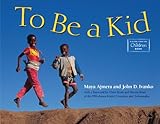The Solution to Reading Comprehension
Lessons & Units :: To Be a Kid Kindergarten Unit
Read-Aloud Lesson: To Be a Kid
Lesson Plan
To Be a Kid

- Learning Goal
- Identify and compare different childhood activities to determine a main idea of the book.
- Necessary Materials
- Provided:
- Detailed lesson plan
- Graphic organizer for guided practice
- Independent student worksheet
Not Provided:
To Be a Kid
-
This lesson is a close reading of the entire text. So it’s important to engage students often, to enhance their learning. Here are two tips:
- When you ask the more complex questions from the lesson, ask students to “turn-and-talk” or “buddy-talk” before answering.
-
Once you are deep into the lesson, instead of asking students every question provided, ask them to share with you what questions they should be asking themselves at that point in the text. This is also a great opportunity to use "turn-and-talk."
- Suggested teacher language is included in the lesson.
- We recommend you read the book once to your students, either the day or morning before teaching the lesson.
- This research-based, read-aloud lesson may seem long. Why do students need the lesson to be this way?
Part 1: Teacher Modeling and Questioning
Write the following student-friendly learning goal on the board, then read the learning goal out loud with the class:
We will learn about different activities kids do around the world. Then we will decide what it means to be a kid.
Transition Students into the Text
Teacher says: You know what it is like to be a kid. But is being a kid the same for people in South America and Europe and other parts of the world as it is for you? Let’s find out.
Read pages 1-3 out loud, then stop. Page 3 ends with, “...your family.” Show students the accompanying photographs. If possible, always show students the photos accompanying the pages you read throughout the lesson.
1.
Teacher asks: We just read two things that being a kid means. One of them is being carried by those who love you. What else does being a kid mean?
Students answer: Being a kid means spending time with your family.
Read pages 5 and 6. Page 6 ends with, “...new things.”
2.
Teacher asks: What else does it mean to be a kid?
Students answer (both of the following responses should be given):
- To be a kid means going to school.
- To be a kid means learning lots of new things.
3.
Teacher says (displaying photos on pages 5 and 6): As you can see, the photos are showing what the words of the book are describing. We read that being a kid means going to school and learning new things. These pictures show kids learning things at school in South Africa, Pakistan, the Philippines, and other countries. Throughout the book, look at the photos to help you understand the words you are hearing.
4.
Teacher says (models thinking): Looking at these photos makes me realize something else, too. Wherever the kids in the pictures are, they are all going to school. Their classrooms and their clothing may be different, but they are all learning new things in school. This similarity makes me think that part of what it means to be a kid is going to school and learning new things. That is true for kids in South Africa, in Pakistan, in the United States, and in many other parts of the world.
Part 2: Guided Practice and Discussion
For this oral lesson, it is suggested to have the completed graphic organizer on the board with the answers concealed. After students provide a correct answer, reveal the corresponding answer on the graphic organizer. Then cross out the corresponding phrase in the “Activities” box below the graphic organizer.
1.
Teacher asks: Look at the first “Picture” box below. Now look at the phrases in the big “Activities” box under all the pictures. Which phrase, or group of words, does the first picture illustrate?
Students answer: The first picture illustrates being carried by those who love you.
2.
Teacher asks: Which phrase does the second picture illustrate?
Students answer: The second picture illustrates learning lots of new things.
3.
Teacher asks: Which phrase does the third picture illustrate?
Students answer: The third picture illustrates sharing a story.
4.
Teacher asks: Which phrase does the fourth picture illustrate?
Students answer: The fourth picture illustrates running races.
5.
Teacher asks: Which phrase does the fifth picture illustrate?
Students answer: The fifth picture illustrates painting pictures.
Part 3: Student Independent Practice
Read each question out loud to your students and have each student complete the worksheet independently. For questions 5 A) and 6, you can have students draw their answers, answer orally, or write their answers, depending on your students’ progress. If you have them write their answers, you may want to write the word(s) on the board for them to copy.
Texts & Materials
Standards Alignment
(To see all of the ReadWorks lessons aligned to your standards, click here.)





Wow! This lesson is amazing! The graphic organizer with illustrations is perfect for my language learners!!
Thank you!!!
I am getting to discover Readworks and I am finding amazing things here! I can't believe what you guys are doing, putting together such great lessons for all teachers to use! Keep up with the good work! God bless!
Abra
I really appreciate the graphic organizer and independent work page because of the use of pictures and word banks. This is perfect to use with newcomer ELLs.